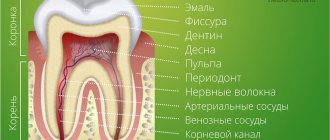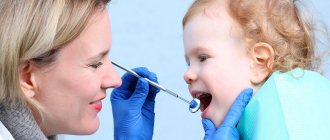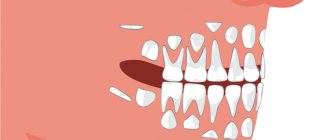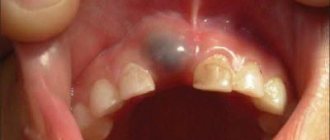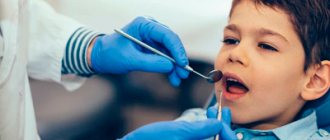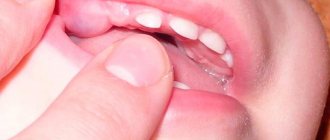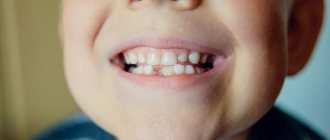Anatomy of permanent teeth
Each molar consists of certain parts:
- crown. This is the part of the tooth that protrudes from the top;
- the root, it goes deep into the alveoli. At the same time, it is attached thanks to special connective tissue bundles. There can be different numbers of roots (1-5 pieces). This moment affects the number of nerves and channels;
- neck. This part is located between the root and the crown.
Tooth tissues are distinguished by their heterogeneity. The enamel is on top and is known for its durability. Once the tooth has erupted, it is covered with a transparent thin layer. This is the cuticle, which eventually changes to the pellicle. The latter is a film that is created from what saliva produces.
Beneath the enamel is dentin, the tissue of the tooth. Dentin is similar to bone when you study how it is built. However, it is more durable because there is a high level of mineralization. In the area where the root is located, the dental tissue is covered with cement. The latter is rich in mineral compounds and is also associated with periodontium. Collagen fibers are used for this.
As for the part of the tooth that is inside, this is the crown and root canal. They are filled with pulp. This is loose connective tissue; it contains nerve endings and blood vessels.
Features of molars
Large molars differ from other groups not only in external characteristics, but also have other features :
- these are the largest units in each dental arch;
- have the largest chewing surface;
- have a powerful root system;
- the upper molars are slightly larger than those on the lower jaw;
- have a stronger surface coating;
- able to withstand weight up to 75 kg;
- upper molars have 4-6 canals, while lower units generally have only 3 canals;
- maxillary molars have 3 roots (palatal, buccal-medial, buccal-distal), less often 4;
- the chewing teeth of the lower jaw have only 2 roots;
- wisdom teeth are the very last molars, which may appear by the age of 50 or not appear at all;
- the last molars are very often located not in the chewing arch, that is, they can grow horizontally or with a slight slope, located buccally or towards the tongue or palate;
- wisdom teeth have from 1 to 5 chewing cusps;
- the last molars often have a complex root configuration (curvature, fusion).
All this entails the peculiarities of treatment of such teeth. The presence of a large number of complex root canals, as well as difficult access compared to other groups of teeth, requires highly qualified doctors and modern equipment for high-quality therapy.
In dental practice, molars are considered the heaviest units, especially wisdom teeth. Proper care and regular preventive examinations will help keep them healthy. When the first signs of damage to the molars appear, we recommend that you immediately sign up for a consultation at our KAS+ dentistry. Timely detection of dental problems guarantees their high-quality treatment with minimal risk and long service life.
Differences between baby teeth and permanent teeth
Permanent and temporary teeth are built in the same way, but still have certain differences between themselves:
- The enamel on baby teeth is whiter. And the enamel on permanent teeth has a yellowish tint;
- the best indicators of density and mineralization are noted behind the molars;
- the pulp of a baby tooth is large in size, and the dense tissues and their walls are thinner;
- permanent teeth are larger in size, here the length is greater than the width;
- The root of baby teeth is short and thin compared to permanent teeth. When the root of temporary teeth is formed, they expand in width. Therefore, the permanent bud has free space to grow.
The health of baby teeth is the path to the safety of primary teeth
Many parents make the mistake of not monitoring the condition of their child's baby teeth. The logic here is quite simple - if they gradually fall out anyway, then why treat? This is a very dangerous misconception.
If caries, periodontal disease and other oral diseases are not treated, you may encounter serious problems with your molars. Among them are abnormal development, enamel damage, inflammation and much more.
We recommend visiting your dentist regularly for preventive examinations. In this case, it may also be necessary to treat caries if such a lesion has begun.
Where do teeth come from?
Teeth begin to form and develop when the fetus is still inside the womb (at about 6 weeks). They have their source - the epithelial dental plate. Already by 14 weeks, active formation of dental tissues, which are hard, occurs. Initially, this occurs in the area where the crown will be, and later at the root.
Molars, namely their first rudiments, appear by the 5th month of the embryo. They are located higher than the child’s baby teeth or lower. By the time the child is born, the rudiments are already practically formed in the tissues of the jaw.
Teeth that belong to an additional group (have no predecessors) are formed later. This occurs after about 1 year of life. Why? Because the baby's jaw is still very small and there is not enough space for them.
Teething in children: symptoms
The first signs of the imminent appearance of teeth appear about a week before their appearance. The symptoms will not stop until the tooth breaks through the gum lining.
Signs of teething in a baby are as follows:
- the child becomes irritable for no reason;
- sleep deteriorates (if the child cries at night and tosses and turns, there is no need to immediately start rocking him to sleep - it is better to give the baby the opportunity to calm down on his own);
- the gums become very swollen and swell at the site where the tooth appears;
- the appetite deteriorates, the baby may even refuse to eat altogether, feeling hungry;
- the child begins to chew on various objects to relieve severe itching in the gums;
- salivation increases;
- Due to drooling, a rash may appear around the mouth, chin and chest.
There are also additional ones, i.e. optional symptoms of teething in infants:
- heat. If the temperature has increased, this most likely indicates an inflammatory process that develops in parallel with teething and is in no way connected with it (it could be stomatitis or any cold).
When the temperature rises, you need to carefully examine the oral mucosa. If there are small bubbles filled with a cloudy liquid, erosion, and the gums themselves are bright red, then the child has herpetic stomatitis. Any baby receives antibodies to the herpes virus from its mother, but usually by the time the first teeth appear, their effect ends. Often the catalyzing factor in the development of stomatitis is trauma to the mucous membrane, which is inevitable when teeth appear. If the above signs cannot be detected, then it is recommended to give the baby Panadol (suppositories are the preferred form of medication). As practice shows, it is useless to call a pediatrician, since this is not their specialization. Only a dentist can determine the specific type of stomatitis (aphthous, herpetic, etc.).
- hematomas on the gums. Sometimes the gums become swollen, turning an eerie shade of blue. Despite their frightening appearance, hematomas do not require treatment. Doctor intervention is allowed only for large hematomas that do not decrease over a long time.
- vomit. The only acceptable cause of vomiting is excess saliva entering the stomach and esophagus. If vomiting begins against the background of elevated temperature and, especially, diarrhea, then these symptoms have nothing to do with teething - you need to call a doctor.
- coughing is not a natural cause when teeth appear, unless the child has swallowed saliva that has entered the respiratory tract.
- A runny nose is a sign of a cold, not teething.
What does a dental formula look like?
To make it more convenient to describe teeth and their number, special formulas are usually used. Each tooth has its own number, which is used to decipher its location.
When describing a milk bite, Roman numerals are used:
- incisors – I, II;
- canine – III;
- molars – IV, V.
If we talk about the formula for adult teeth, here the teeth are counted starting from the center:
- incisors – 1.2;
- fang – 3;
- molars (small) – 4.5;
- molars (large) – 6,7,8.
8 is a wisdom tooth; not every person has it.
Caring for children's teeth
The pattern of teething in children determines the approximate time of their appearance, but it is necessary to start observing oral hygiene as early as possible, without waiting for the teeth to erupt.
Breasts cannot take care of themselves, so they need help cleaning their gums. This is done either with the help of a fingertip, or, if there is none, with the help of an ordinary bandage dipped in warm boiled water and wound around the finger.
If teeth begin to erupt, you cannot do without the use of special products (baby pastes, brushes, etc.).
Teething order
Typically, all children start teething at about the same time. Teeth emerge from the molar set at the age of 5, and it is the molars (large ones) that emerge. Then the diagram is as follows:
- Initially, the incisors on the lower jaw change, which are located in the center;
- then the central incisors appear on the upper jaw and the incisors on the sides on the lower jaw;
- at about 8-9 years old, the incisors on the top and sides change;
- up to 12 years of age, molars (small) grow;
- at the age of 13, the fangs change;
- after the child turns 14 years old, the second molars (large ones) come in. They were not included in the milk kit;
- and after another 1 year the third molars (large) appear. This is a wisdom tooth. But he may not appear at all.
Life cycle of teeth
Almost all the organs of our body are formed in the womb. Teeth are no exception. Already at the age of 6 weeks, the rudiments of the first teeth appear in the fetus: 10 pieces each. on the upper and lower jaw. Total - 20 small “buds”. This is the future milk bite.
See an interesting infographic about what kind of life our teeth live, and immediately after - in more detail about each stage and useful tips on how to preserve your teeth until old age.
Life cycle of teeth
| Birth | A child is born with fully formed tooth buds - they are located just under the surface of the gums. It is also interesting that some babies are already born with one or more teeth |
| 2-3 months | The baby begins to cut his first teeth. This is a rather unpleasant process, which is accompanied by excessive salivation, pain, deterioration of the child’s mood, and refusal to eat. In addition, during teething, local immunity is significantly reduced, which increases the risk of developing a viral infection. This explains the frequent increase in temperature during this period. |
| 6-14 months | Teeth begin to appear. The lower incisors grow first, then the upper ones. In total, the child should grow 20 pieces, including 2 multi-root chewing ones on each side - this will be the milk bite |
| 6-7 years | At this time, “baby” teeth begin to fall out. There is a change from a milk bite to a permanent one |
| 12-13 years old | The period of complete completion of the formation of a permanent dentition. By this age, the milky ones should fall out completely, and permanent ones should grow in their place. Helping teeth fall out in most situations is not required - this is a natural and physiological process that does not require third-party intervention. But it’s still worth seeing a doctor: it’s important to monitor both the wound and the process as a whole |
| 17-21 years old | During this period, “wisdom teeth” – the furthest ones in the row – may grow. There are 4 of them in total. There were no dairy predecessors in their place, so they have to pave the way on their own. In addition, they grow at a time when the bone tissue is fully formed and very hard. That is why their growth is associated with such problems as pain, acute inflammation of the mucous membrane, incorrect position in the row and even retention (the tooth does not erupt, forms and remains completely in the bone tissue) |
| 20 years and older | Starting at this age (and if there are problems with the body or when playing dangerous sports, even earlier), we begin to lose teeth. In the absence or poor hygiene, with poor nutrition, and the appearance of diseases of many organs and systems of the body, the enamel becomes weaker and is subject to attack by bacteria. With age, the amount of saliva decreases - and it is this that is a natural means of cleansing plaque. This is largely why teeth and gums become more susceptible to decay. It is also worth remembering that not only dental diseases, but also problems with gums lead to loss. |
How to determine that a child will soon have molars?
There are certain signs that indicate that permanent teeth will soon begin to erupt:
- The spaces between the teeth increase. The jaw grows and the free space increases;
- baby teeth become loose as the root gradually dissolves. It cannot be firmly fixed in the jaw tissues;
- in case of loss of a temporary tooth. This confirms that the molar will soon come out as it has pushed out the previous one;
- The gums are slightly swollen and red.
When permanent teeth erupt, the child’s general well-being usually remains the same, the temperature does not rise, and there is no pain.
Is it necessary to remove baby teeth and what to do if they fall out?
Many people have been familiar with situations since childhood when a baby tooth is removed at home. The problem is that this is done incorrectly, often in violation of sanitary requirements. There are a lot of possible risks in such a situation - from infection to severe damage to the gums, which will lead to problems with the root row.
The decision to remove, as well as the operation itself, can be carried out exclusively by the dentist after examining the small patient and carrying out all the required diagnostic procedures.
There are two reasons for making the decision to delete directly. These include:
- Interfering with the normal eruption of a molar, risking its curvature.
- The presence of an inflammatory process for various reasons.
The removal process begins only if severe loosening occurs and there is a risk of causing severe discomfort or injury to the gums.
You also need to comply with the requirements for normal loss. Pay attention to the condition of the wound:
- If there is no bleeding. All you need to do is stop eating and drinking for two hours. Also, you should not put any traumatic impact on the gum at the site of loss - watch this. You can use a prophylactic remedy - rinsing with a solution of a glass of water, two tablespoons of salt and two drops of iodine. This has a good disinfecting effect.
- If there is bleeding. This is quite normal. To deal with it, you just need to bite on a cotton swab for 5-10 minutes. If the blood flows heavily and does not stop, despite your efforts, all that remains is to see a dentist.
Possible problems
Permanent teeth have just appeared, but this does not mean that there will not immediately be any problems associated with them. Parents should be aware of possible dental problems:
- lack of molars;
- pain in the molar area;
- crooked position of molars;
- molars fall out;
- injuries.
For any of these problems, it is important to contact a specialist in time to receive qualified help.
When do the first primary molars appear?
Molar teeth appear early in children. After a tubercle grows on the gum, little white spots appear. The milk molar organ appears between 1 and 2.5 years. They erupt painfully. By this time, the children’s chewing reflex has already developed. Children immediately use these chewing organs, because the consumption of solid foods without them was problematic. Tough food speeds up the process of jaw formation.
The deciduous bite contains eight molar units. Although the organs are located behind the fangs, they appear earlier from them. They come out in pairs. The chewing organ in the bottom row is shown first. Behind it appears a unit on the upper jaw. Second primary molars appear after 2 years of age. Sometimes it happens a little later or earlier. Dentists consider this normal. In order not to miss pathologies, if teething occurs later or earlier, it is worth showing the baby to a pediatrician and dentist. Deviation from the generally accepted pattern may be due to heredity or genetic predisposition.
The activity of the appearance of units increases by 24 months, that is, during the period of emergence of the second temporary chewing organs. The whole set appears by 30 months. Teeth replacement usually begins at age five and continues until age twelve. Molar units change the fastest. The order of replacement is the opposite of the pattern of appearance. Bone elements can grow in the free space that appears due to the fact that the jaw has grown. The first signs of loss of a time unit are swaying. You should wait until the rudiment falls out on its own. If it is removed, the permanent unit may appear in the wrong place, causing displacement of the masticatory organs.
Symptoms of appearance
Since the first molars are the largest rudiments, their chewing surface is extensive and their roots are large. Therefore, all mothers and fathers remember their birth, because they come out painfully. Only some babies do not experience discomfort. But this is a rare case. In other situations, many problems arise. Main symptoms:
- Rapid swelling of the gums.
- Increased salivation.
- The little ones become very restless.
- Sleep gets worse.
- Kids refuse to eat.
- Body temperature rises.
- If the body's defenses are reduced, a runny nose may appear.
- Sometimes babies suffer from diarrhea.
When tubercles with sharp edges sharply break through the gum tissue, babies suffer greatly from this. It happens that at the same time the growth of fangs begins. And these are the most painful sensations. The main symptom of the appearance of permanent units is the growth of the jaw, which entails the appearance of free spaces behind the temporary rudiments. At this point, permanent chewing organs will emerge. Gaps also appear between teeth. They ensure the even position of the indigenous bone organs.
To alleviate the condition of the little ones, pediatric dentists prescribe painkillers that will not cause harm to the body, and special rings for massaging the gums. A tasty syrup for toddlers is often recommended. When temporary rudiments change to permanent ones, the child needs to rinse his mouth. If the wound is bleeding, a soda solution will help. When severe swelling appears, the baby should be shown to the dentist. Dangerous complications can be avoided if you regularly visit the dentist and take good care of your oral cavity.
